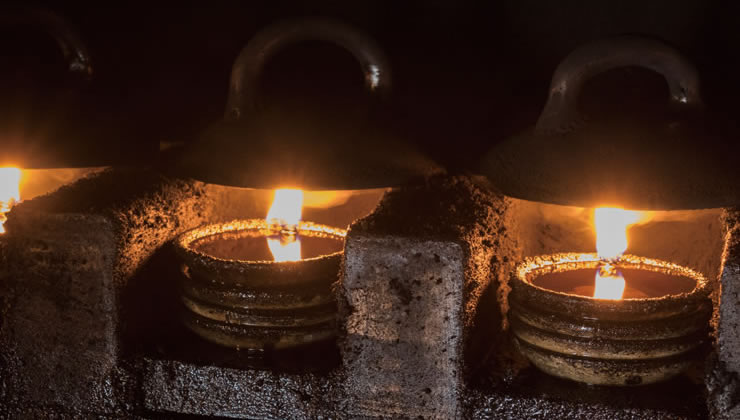
 |
|



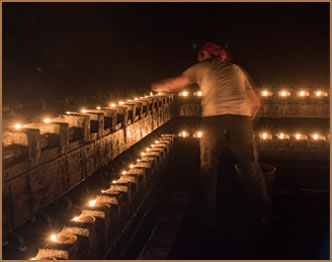 |
 純植物性油を土器に入れ、藺草でつくった芯に火をともして土器の覆いをかぶせ、その内側についた煤煙をとります。煤のつき方が偏らないように20分おきに土器を回していきます。火の加減、油の量にも気をつかう非常に繊細な作業です。
Professional artisans pour pure vegetable oil into earthenware with a cover. It has a wick made from rush in it then put on fire. They collect the dark soot that forms on the inside of the seat. They have to tum a round the earthenware every 20 minutes not to unbalance the dark soot. The quality of sumi is depending on condition of fire and grade of oil. So this process is very sensitive and one of the most important parts. |

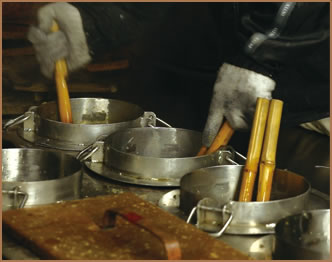 |
 上質の膠を深さ30ほどの「たんぽ」と呼ばれる銅壺に入れて、70度のお湯で時間をかけゆっくりと湯煎をし、膠の溶かした液を作ります。
In order to make the other important ingredient, artisans put fine gelatin from cowhide and gradually dissolve it in 70℃ of hot water in copper pot called Tampo which is 30cm in depth. |

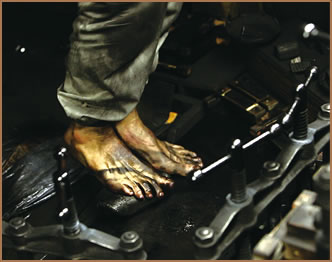 |
 丹念につくられた煤と膠の溶液を100対60の割合でよく混ぜ合わせ、この時香料も入れてよく練り上げます。この練り具合で墨の生命が決まります。
Then, they carefully mix main ingredients, dark soot and gelatin, in a proportion of 100 to 60. As it starts to shine black, add some scents. Kneading is the most important process to determine the grade. |

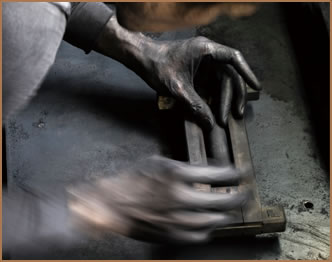 |
 墨の文字、図柄が彫ってある梨の木で作られた木型に、光沢の出るまでよく練られた墨を型入れします。墨の一丁形の目方は15gですが、木型に入れる時は、まだ墨玉に水分が多く含まれている為、約25gとなります。
Artisans put a well-kneaded sumi into a mold made from pear trees, on which designs or characters are engraved. 25g of sumi is out into a wooden mold to make 15g of block of sumi. This is because it shrinks when it gets dry. |

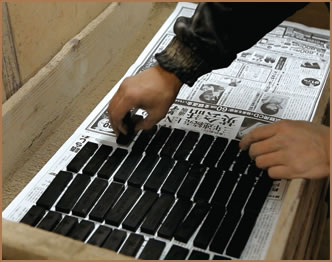 |
 木型から取り出した墨は、第1日目は水分の多い湿った木灰に埋め、2日目以降は徐々に水分の少ない木灰に埋めかえていきます。この灰乾燥は小型のもので1週間、大型のもので30日~40日程度続けます。
The sumi taken out from wooden mold is put into moist ashes on the first day. After second day, artisans gradually replace ashes to less moist ones day by dayto make sumi dehydrate. This process takes about a week for a small piece and about 30 to 40 days for a big piece. |

 |
 灰乾燥が終わり、約7割の水分が除かれた墨は、藁で編んで天井から吊るして室内(自然)乾燥をします。
通常約1ヶ月~6ヶ月を要します。 After dehydration process in ash, about 70% of moisture is taken away from sumi. Then sumi is hanged and dried in-house with straw. This process usually takes from a month to six months. |

 |
 自然乾燥を終わった墨は表面に附着した灰を1丁ずつ水で洗い落とします。その後炭火で焙り、微に表面を柔らかくして蛤の貝殻で磨き、美しい光沢を出します。
After finishing the natural drying, artisan washes ash or dust carefully. And then, a glazed layer is formed by coating the surface of a body of the sumi ware with a glaze, and firing. He uses clamshell to polish on surface to make it shine. |

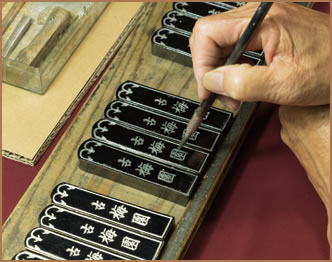 |
 丹精込めてつくられた墨は、更にしばらくの間、自然乾燥した後金粉や銀粉またいろいろな顔料を用いて彩色します。独特の特徴ある墨の紋様もこの彩色でより美しく鮮明にあらわれてきます。
Polished sumi needs for a little more time to get rid of moisture from the washing and be dry. When drying is finish they paint the surface with gold powder, silver powder and pigment. The unique molded pattern of the sumi appears brightly and sharply with the process. |
![]() 株式会社 古梅園
株式会社 古梅園 ![]()
![]() Copyright(c) 2020 kobaien All Rights Reaeved.
Copyright(c) 2020 kobaien All Rights Reaeved.